New Zealand
Things to DO
Napier
On 3 February 1931, most of Napier was levelled by an earthquake. The collapses of buildings and the ensuing fires
killed 256 people.
The centre of the town was destroyed by the earthquake, and later rebuilt in the Art Deco style popular at that time. Although
a few Art Deco buildings were replaced with contemporary structures during the 1960s, 1970s, and 1980s, most of the centre remained
intact
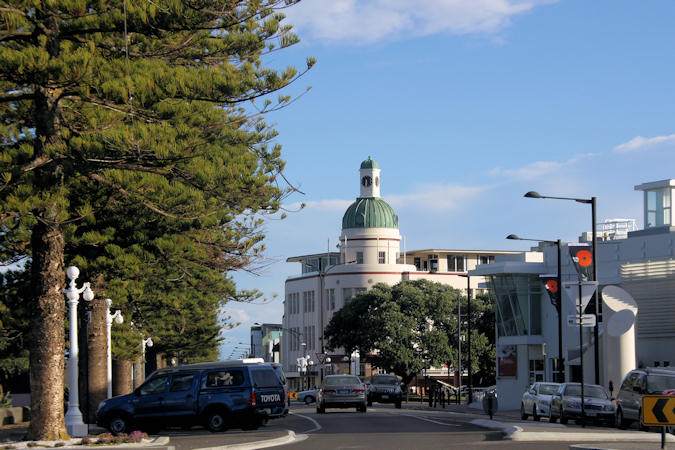 |
|||||
for long enough to become recognised as architecturally important, and beginning in the 1990s it had been protected and restored.
Statues of soldiers atop a pedestal were a common central feature of South African War memorials.
Napier’s was the only one featuring a trooper in a posture of mourning with his rifle pointed down. It was unveiled by Governor
Lord Plunket at a large community ceremony on 11 February 1906.
Construction of the present Waiapu Cathedral of Saint John the Evangelist, was completed 1965, and the cathedral was
consecrated on 8th October 1967.
The present-day building replaced original cathedral of St John complete by 1890.
Napier's Sound Shell, built in 1931 is a popular Napier entertainment venue with both private and public events being
held there.
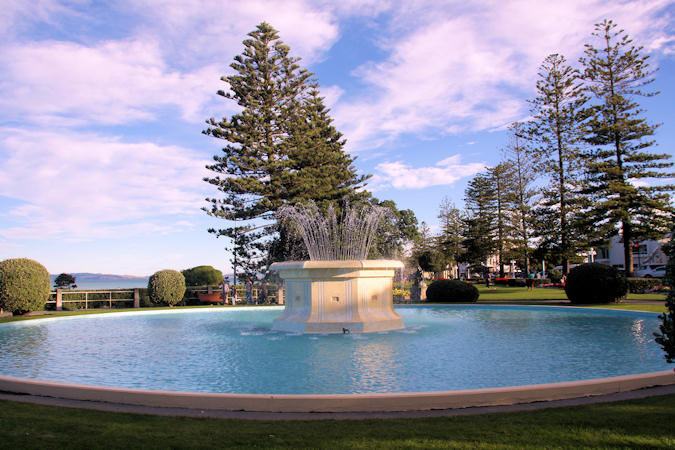 |
|||||
Tom Parker Fountain; built in 1936 from funds donated by Tom Parker, a local merchant. Owned by the Napier City council
this is one of most spectacular water fountains in New Zealand - a real piece of Art Deco history.
Waipunga Falls is situated 70 km north-west of Napier plunging some 40 metres from the Waipunga River. The waterfall is
segmented into three thick columns while almost joined by a barely-visible companion waterfall to the left called Waiarua Falls.
From mid-september to late April, Cape Kidnappers, about 20 kilometres south-east of Napier, erupts with 13.000 squawking
Australasian gannets. These large ocean birds usually nest on remote islands but here they settle for the mainland, completely
unfazed by human spectators. It's the world's biggest mainland gannet colony.
The birds nest as soon as they arrive and eggs take around six weeks to hatch, with chicks arriving in early november. In march the
gannets start their migration; by may they're gone.
Gisborne
Gisborne is the place where British navigator Captain James Cook made his first landing in New Zealand
upon the "Endeavour".
Cook had earlier set off from Plymouth, England in August 1768 on a mission bound for Tahiti. Once he had concluded his duties
in Tahiti, Cook continued south to look for a large landmass or continent.
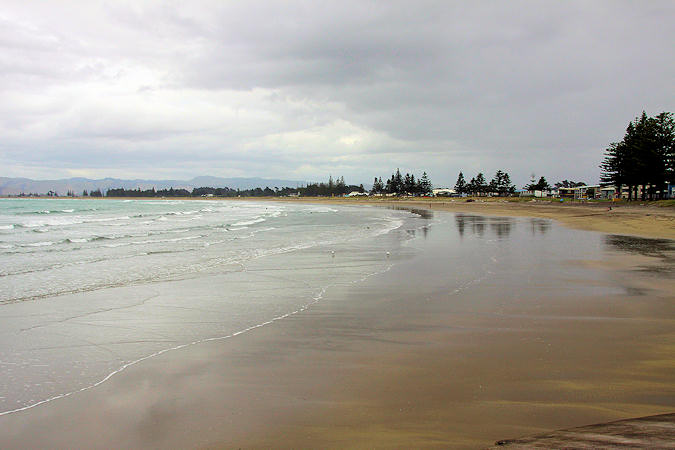 |
|||||
On 9 October 1769, Cook came ashore on the eastern bank of the Turanganui River, accompanied by a party of men. Their arrival
was marred by misunderstanding and resulted in the death and wounding of nine Māori over four days.
In dismay for not getting provisions, Cook named the area Poverty Bay as "it did not afford a single item we wanted"
Starting in the early 1830s, traders set up the first trading stations along the Turanganui river and are attributed to the
founding of the town. Over the next 30 years, many more European traders and missionaries migrated to the region.
Wiremu "Wi" Pere (1837 – 1915), was a Māori Member of Parliament in New Zealand. Pere's strong criticism of the government's
Māori land policies and his involvement in the turbulent land wars in the 1860s and 1870s made him a revered Māori leader
and he was known throughout his career as an contentious debator and outstanding orator in the use of the Māori language.
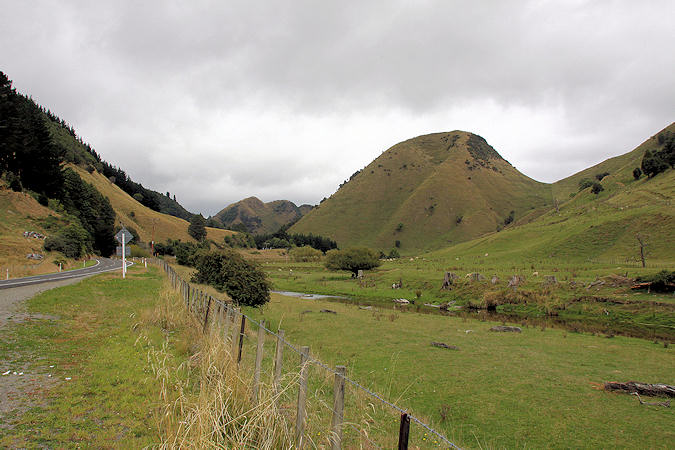 |
|||||
Situated on State Highway 2, 75km north-west of Gisborn, Waioeka Gorge Scenic Reserve is a 1800 hectare area of native
forest and regenerating farmland. Some of the reserve was cleared for farming after World War 1, but the settlers couldn’t produce
enough from the land to make their efforts worthwhile.
They left behind them the Tauranga Bridge, the only surviving harp suspension bridge left in New Zealand. It was built in
1922 by the Public Works Department to provide access to sheep farms up the Tauranga Valley.
From a tower at one end, each suspension cable passes under a different bridge crosspiece, before rising to the tower at the other
end. This creates an unusual and attractive 'harp-like' pattern, hence the term harp suspension bridge.
Rotorua
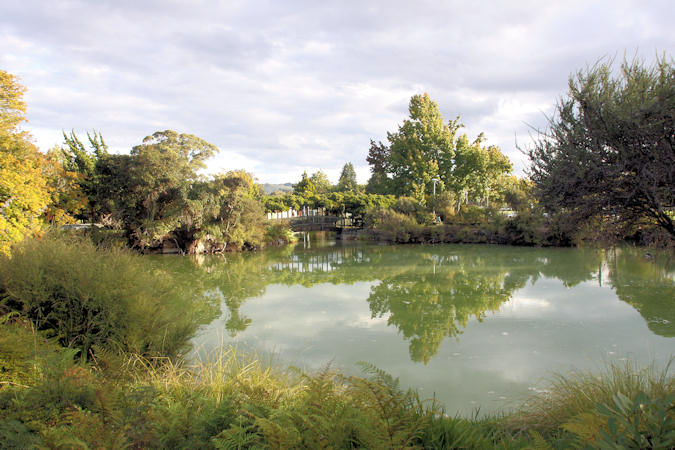 |
|||||
Rotorua, a town set on its namesake lake, is renowned for its geothermal activity and Maori culture.
On the outskirts of Rotorua you can find the lively Kuirau Park, a popular community attraction with a twist.
Beneath the park’s surface geothermic activity is bubbling away. Several walkways take you through Kuirau Park to see the crater
lake, mud pools, hot springs, and a free thermal foot bath, all set in a beautifully manicured setting dotted with flower beds
and native flora.
Over a century old, the historic St. Faith’s Anglican Church is one of the oldest religious structures in the Rotorua
area and offers great insight into local Māori culture.
This wooden church was completed in 1914 and remains active to this date. Visit during the week to see its intricate carvings,
woven panels and stained-glass windows.
Tauranga
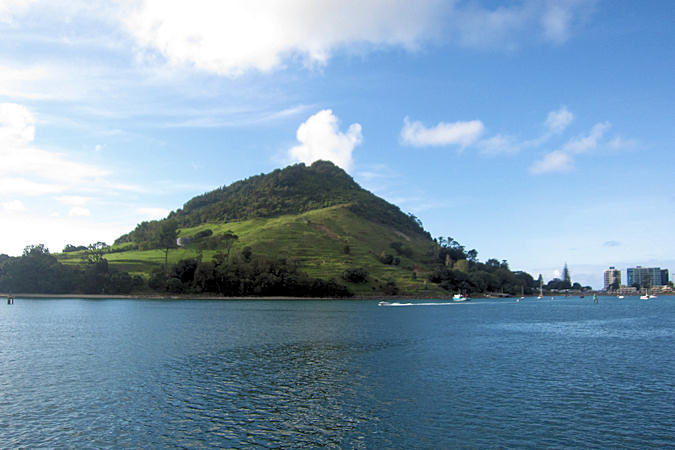 |
|||||
Tauranga is the most populous city in the Bay of Plenty region in the North Island of New Zealand.
It was settled by Maori late in the 13th century, providing a pleasant climate, fertile land and welcoming harbour. Europeans
arrived in the area in the early 19th century and Tauranga was constituted as a city in 1963.
Occupying a narrow peninsula punctuated with an ancient volcanic cone, Mount Maunganui is an uptempo beach town with
therminal hot pools, lively cafes and hip bars. Despite being swallowed by Tauranga in 1989, itretains a distinct identity, shaped
largely by it sun-soaked surf vibe.
The Tauranga harbour is one of New Zealand's largest natural harbours and is home to the country's biggest export port.
As you enter Tauranga Harbour, you are greeted by a sculpture of Tangaroa, the Māori god of the seas.
The deity is holding a traditional warrior club ("mere") and a battle staff ("taiaha"). Tangaroa’s crouched
position represents wero, a ritual used to determine a visitor’s good or bad intentions.